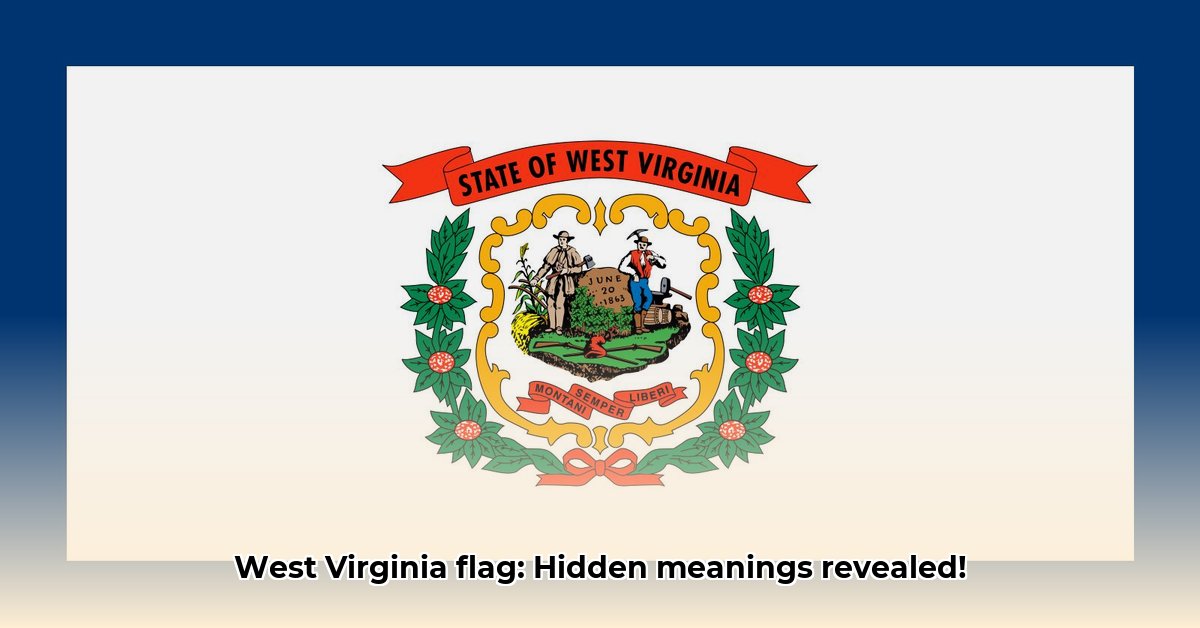
West Virginia state flag symbolism explained: A deeper dive
West Virginia's state flag, adopted in 1929, is more than just a colorful banner; it's a powerful visual narrative encapsulating the state's history, values, and identity. Its design, a carefully crafted blend of symbolism and practicality, offers a fascinating glimpse into the heart of West Virginia. But how much do you really know about the meaning behind its vibrant colors and iconic imagery? Let's delve into the rich tapestry woven into this powerful symbol. For a visual representation, see the West Virginia state flag.
More Than Just Cloth and Colors: Unraveling the Story
The flag's deep blue border immediately commands attention. This vibrant hue, a direct echo of the national colors, serves as a powerful visual reminder of West Virginia's unwavering allegiance to the United States, a bond forged in the crucible of the Civil War and strengthened through over a century of shared history. It’s a declaration of unity and shared heritage, far beyond a mere aesthetic choice. The central, pristine white field – sharp, clean, and unblemished – provides a stark contrast and symbolizes purity, innocence, and perhaps, a fresh start for a state carving its own identity.
At the heart of this composition resides the state seal, a vibrant emblem teeming with storytelling potential. Dominating the seal are two key figures: a farmer and a miner. These are not merely illustrations; they represent the very pillars of West Virginia's economic foundations. The farmer, with his tools of the trade, embodies the state’s rich agricultural legacy, the generations of families who have tilled the fertile valleys, and the enduring connection to the land. Alongside him stands the miner, a powerful symbol of West Virginia’s industrial might, highlighting the significant role of mining – principally coal mining – in shaping the state's economy and identity. The juxtaposition of these two figures beautifully captures a critical duality; the balance between agricultural traditions and the power of industrial development that defines West Virginia.
Towering above these essential figures sits a Phrygian cap, a potent symbol of liberty and revolution dating back to ancient times. In the context of the West Virginia flag, it stands as a powerful testament to the state’s unwavering commitment to freedom and self-determination – a value intrinsic to the West Virginian spirit. It represents the relentless pursuit of independence, a rejection of oppression, and a reflection of the state’s tumultuous history. Flanking the cap, crossed rifles add another layer of visual narrative; they either represent a strong commitment to protecting hard-won freedoms or embody a sense of steadfast duty and a readiness to defend one’s values. Historians continue to debate the precise interpretation of this powerful symbol.
Finally, everything is united by the state motto, "Montani Semper Liberi," eloquently translated as "Mountaineers are Always Free." This poignant phrase embodies the independent, resilient spirit of West Virginia's people – their tenacious heritage, their unwavering determination, and their proud legacy.
From Seal to Flag: A Journey Through Time
The West Virginia flag wasn't spontaneously conceived; it's the culmination of a thoughtful evolution, a refinement of the state seal, a living document constantly adapting and evolving while remaining true to its core message. While the 1929 version is the official iteration, earlier attempts offer valuable insight into the state’s evolving priorities and the ongoing process of defining its visual identity.
Beyond the Surface: Unpacking the Meaning
Understanding West Virginia's flag requires more than simply identifying its colors and symbols. It's about grasping its historical context, appreciating the values it embodies, and understanding the compelling story it conveys. It's a powerful representation of the state’s rich history, the trials it has overcome, and the unyielding spirit of its people.
The Ongoing Story: Further Exploration
While the primary symbols are generally understood, opportunities for further research remain. Historians continue to investigate the flag's creation, seeking to illuminate the creative processes and social contexts that shaped its design. Further investigation might reveal unexpected connections between design choices and specific historical events or figures, ensuring the flag's continued relevance and inspiring future explorations.
How did West Virginia's state flag design evolve from 1905 to 1929?
The journey of West Virginia's flag from its inception to its official adoption in 1929 reveals a fascinating blend of artistry, practicality, and historical symbolism. The initial inspiration stemmed directly from the state seal, adopted in 1863, which already contained the core elements that would shape the flag’s design. The early attempts to translate the seal into a practical flag design were frequently hampered by complexity, making them expensive to manufacture, especially double-sided versions. This practical consideration played a crucial role in the eventual design choices.
The successful 1929 design struck a beautiful balance between simplicity and symbolism. It retained the central elements from the state seal, but simplified its construction, making it more cost-effective to produce. The use of a crisp white field for the background, framed by a deep blue border, proved both visually striking and cost-efficient. Subtle variations in color and artistic rendering may exist between the earlier versions and the standardized version, illustrating the inherent difficulties in precisely replicating a design over time and across different manufacturers.
Key Takeaways:
- The West Virginia state flag’s evolution is a testament to the interplay between artistic vision and practical concerns.
- Early design attempts were often complex and costly to produce.
- The 1929 design successfully distilled the essential symbols of West Virginia's history into a simple, yet powerful design.
- Minor variations reflect the inevitable challenges of replicating designs across different times and manufacturers.
- The flag’s journey mirrors West Virginia’s own evolution, balancing tradition with practical considerations.